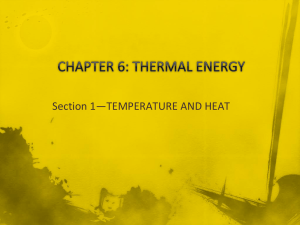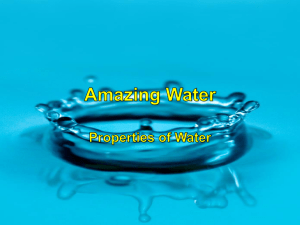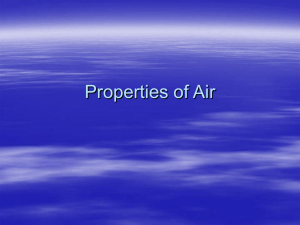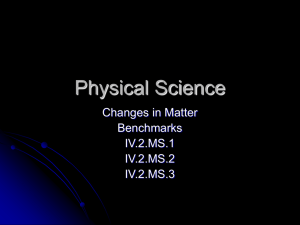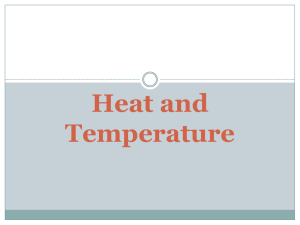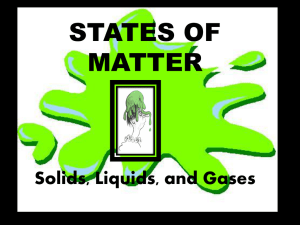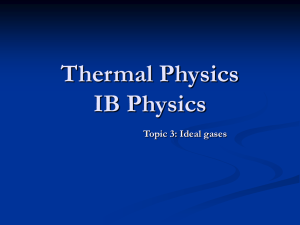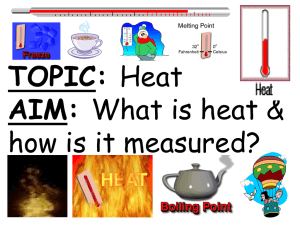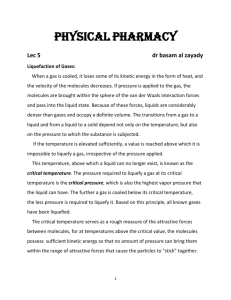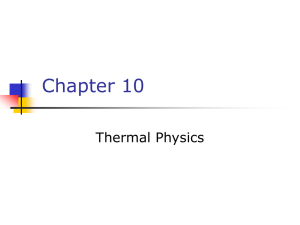Heat, Temp, Thermal Expansion
advertisement
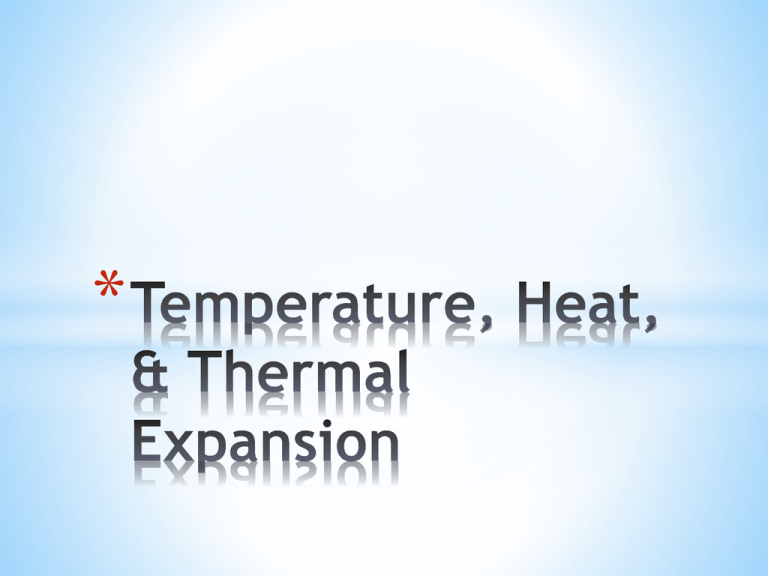
* * Measured in K, ºC, ºF * Lower limit … 0 K * Upper limit … none * K and ºC have the same scale, just offset * Practice converting to all three scales: * 50ºF * 10ºC * 550 K * * No!! * Heat … measured in J, a form of ENERGY * Temperature is a measure of the AVERAGE kinetic energy of ALL the molecules in the substance. * More motion (vibrations) = more KE * More KE = higher Temp. * Rationalize why this makes sense… * * The sum of all of the molecules’ KE * Even if it is colder, if there is more of that substance, then it will have a greater Thermal Energy * Ex. Hot chocolate vs. the Atlantic in winter * * There is twice as much molecular kinetic energy in 2 liters of boiling water as in 1 liter of boiling water. Which will be the same for both? * A. * B. * C. * D. Temperature Thermal Energy Both A and B. Neither A nor B. * Answer: A. Avg. KE of molecules is the same. * * To say that body A has a higher temperature than body B is to say that body A has more * A. * B. * C. * D. Internal Energy. Mass. KE per particle. PE * Answer: C * * Internal energy transferred due to unequal temperatures * Heat flows until thermal equilibrium is reached * What is that? * ALWAYS flows from hot to cold. * An object does NOT contain heat. * * If a red-hot thumbtack is immersed in warm water, the direction of heat flow will be from the: * A. * B. * C. * D. Warm water to the red-hot thumbtack Red-hot thumbtack to the warm water There will be no heat flow Not enough information * Answer: B * * Heat is ENERGY * Joules * Instead, calories are used. * 4.186 J = 1 cal * Food calories are NOT the same. * 1 food calorie = 1 kilocalorie (kcal) = 1000 cal * * The same quantity of heat is added to different amounts of water in two equal-size containers. The temperature of the smaller amount of water… * A. Decrease more. * B. Increases more. * C. Does not change. * D. Not enough information * Answer: B. * * You heat a half-cup of tea and its temperature rises by 4ºC. How much will the temperature rise if you add the same amount of heat to a full cup of tea? * A. * B. * C. * D. 0ºC 2ºC 4ºC 8ºC * Answer: 2ºC * * As substances are heated… * Motion increases * KE increases * Molecules move faster and further apart * Substance expands! * Opposite when cooled. * Different substances expand at different rates * Greater in liquids than in solids * More liberty to move * Important for construction!! * • Use of reinforcing steel with the same rate of expansion as concrete— expansion joints on bridges. • Gaps on concrete roadways and sidewalks allow for concrete expansion in the summer and contraction in the winter. * Rail Buckling * When stringing telephone lines between poles in the summer, it is advisable to allow the lines to… * A. * B. * C. * D. Sag Be taut Be close to the ground. Allow ample space for birds. * Answer: A…Telephone lines are longer in a warmer summer and shorter in a cold winter. Hence, they sag more on hot summer days than in winter. If the lines are not strung with enough sag in summer, they might contract too much and snap during the winter— especially when carrying ice. * * Water molecules form a crystalline structure when they become a solid. * Each water molecule takes up more space than when it was a liquid because of the bonds it makes in its crystalline structure * *As water molecules get colder, they take up less space (cold things contract), until ~4C (39F). This is the maximum density of water *Below 4C, water begins to form its crystal structure as it approaches its freezing point, decreasing density *As water gets warmer, molecules expand,decreasing density *Important for ocean circulation, heating of Earth, and overturning of fresh bodies of water * * When a sample of 0C water is heated, it first * A. Expands * B. Contracts * C. Remains unchanged * D. Not enough information * Answer: B. Water continues to contract until it reaches a temperature of 4C. With further increase in temperature beyond 4C, water then expands. * * When a sample of 4ºC water is cooled, it… * A. * B. * C. * D. Expands Contracts Remains unchanged Not enough information * Answer: A. Water will start to take its crystalline structure. *
